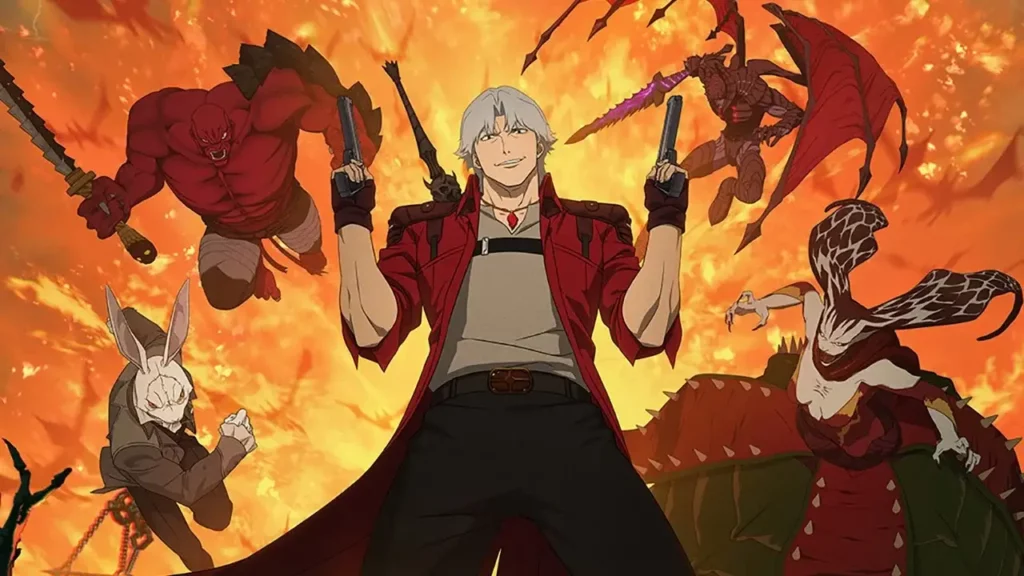Netflix’s new Devil May Cry series reimagines Capcom’s legendary action game for the small screen, delivering an eight-episode animated reboot that fully embraces its early 2000s roots. Though it introduces a fresh continuity for new viewers, the show still channels the energy and aesthetic of the PS2 era with gusto—complete with aggressive nu-metal soundtracks, moody lighting, and exaggerated action sequences.
This version of Dante, voiced by Johnny Yong Bosch, is younger and somewhat adrift in a world slowly unraveling into chaos. A demon uprising, orchestrated by a suave villain known as the White Rabbit, is underway. At the same time, a human-run agency is mobilizing to prevent the merging of realms. Dante, unaware of his deeper connections to these events, becomes the reluctant focal point of a war between dimensions—armed only with his mother’s stories and a family heirloom the demons desperately seek.
New Faces, Familiar Energy
The narrative begins with world-building and character setup, spotlighting not just Dante but a large supporting cast that includes Lady and her demon-hunting squad, and a fanatical political figure named Vice President Baines. Voiced by the late Kevin Conroy, Baines brings a theatrical intensity to the ensemble. While the first half of the season focuses heavily on setup and secondary characters, longtime fans may find themselves longing for more of the high-octane action the franchise is known for.
Fortunately, the pacing shifts around the season’s midpoint. As characters fall away and the core narrative gains clarity, the show begins to resemble the Devil May Cry fans know and love. This more streamlined back half puts Dante front and center, bringing stylish battles and sharp humor into the spotlight.
Action That Delivers—and Then Some
Once the action ramps up, Devil May Cry shines. The combat sequences echo the fluid, exaggerated violence of the games, with Dante pulling off impossible stunts while delivering witty quips and wild acrobatics. The animation is slick and energetic, blending camp and carnage in equal measure. Early fights serve as stylish palate cleansers between heavier exposition, but by the final episodes, these scenes gain emotional weight and narrative purpose.
Despite its sometimes slow setup, the show offers fans the experience they came for—over-the-top battles, dark fantasy spectacle, and a Dante who straddles the line between swaggering rogue and tortured soul.

A Love Letter to Longtime Fans
While other Netflix adaptations like Castlevania and Cyberpunk: Edgerunners appealed broadly to gamers and non-gamers alike, Devil May Cry feels more targeted. The show revels in nostalgic cues from the early 2000s, from its soundtrack choices to its character designs. The opening scene set to Limp Bizkit’s “Rollin’” signals early on that this adaptation isn’t shy about its tone or inspirations.
For viewers unfamiliar with the games, this stylistic throwback may come across as dated or overly self-aware. But for those who grew up with Dante’s demon-slaying antics, it’s a knowing wink—an unapologetic embrace of a bygone era of video game storytelling.
A Promising Start With Room to Grow
Devil May Cry may not immediately find its footing, but it sets the stage for something bigger. Its final episodes suggest a shift toward more focused storytelling in future seasons, with a streamlined cast and stronger emphasis on Dante’s journey. While not every subplot lands, and the exposition-heavy first half might test some viewers’ patience, the payoff is stylish, satisfying, and packed with potential.
Netflix’s take on the franchise successfully captures the essence of what made Devil May Cry iconic—its brash attitude, kinetic energy, and chaotic charm. If the next chapter leans further into these strengths, there’s every reason to believe this animated series will carve out a lasting place in the growing pantheon of game-to-screen adaptations.
Read more reviews here.
